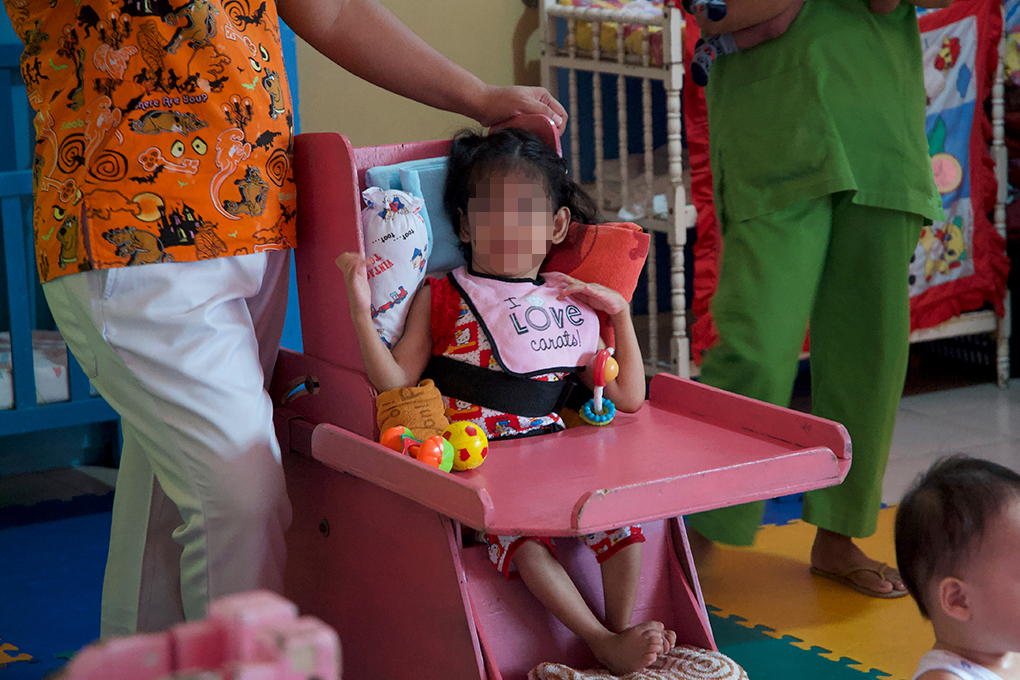
Holt’s Child Nutrition Program
Helping thousands of vulnerable children worldwide
Why Holt’s Child Nutrition Program Is Important
Malnutrition affects nearly 250 million children worldwide and malnutrition and hunger-related diseases are the biggest killer of children under age 5 in the developing world.
The children Holt serves globally through our child nutrition program are among those most at risk for malnutrition and hunger-related diseases. These include orphaned or abandoned children, many of whom have significant disabilities.
Since 2014, Holt has expanded our work across China, Ethiopia, Haiti, India, Mongolia, the Philippines, Uganda and Vietnam to train caregivers in proper nutrition and feeding practices, and to teach our partner staff how to track children’s nutrition and growth in the first critical years of life.
“The children looked healthy, so we did not realize that many had iron deficiencies. The Holt Child Nutrition Program gave us the tools to understand. The children are healthier, so we have to give them medication less often. When there is less sickness, our jobs are easier.”
Mr. Chui, Director of Childcare at a Site in China
How Holt’s Child Nutrition Program Works
Holt International’s child nutrition program is a nutrition and feeding intervention with a “Training of Trainers” structure to support better nutrition and feeding practices among caregivers resulting in improved health and development outcomes for vulnerable children, especially for infants and those with disabilities. By intensively training local champions to train others, we maximize our outreach.

Training Caregivers
- Multiple-day, in-person training sessions with on-the-ground staff and caregivers at partnering programs and care centers overseas.
- Training covers core nutrition, health and feeding curriculum as well as hands-on practicum.
- Once caregivers are trained, they become CNP champions able to train others.

New Tools
- Holt equips partners with nutrition and feeding manuals, translated into their local language.
- All necessary equipment is provided to ensure that our partners are prepared to accurately assess and monitor the health and nutrition of children and provide any interventions needed to improve their overall health and wellbeing.

Nutrition and Feeding Interventions
- At-risk children at partner sites receive more nutritious, diverse meals as well as any essential vitamin and mineral supplements they need.
- Trained caregivers are equipped to provide enjoyable mealtimes for children with safe feeding techniques.

Assessing Children
- Caregivers track and monitor the health and development of children through routine nutrition screenings, enabling early and effective interventions for malnutrition and illnesses.
- Holt provides standardized equipment, including a tool to test for anemia, as well as an electronic health record system to ensure children’s growth and health status are being properly recorded and analyzed over time.

Sustainable and Scalable
- Once the program has been successfully implemented at a site, new sites are identified for scaling and CNP champions begin the process again.
- Strong monitoring and evaluation of the program helps to continually improve program implementation.
The Prevalence of Malnutrition in Holt’s Child Nutrition Program
The children entering the CNP are at high risk of malnutrition with 47% experiencing some form of malnutrition at their first screening. Malnutrition is associated with increased mortality rates, as well as reduced cognitive ability, compromised ability to fight infection, and poor school and job performance.

Stunting
Too short for their age

Wasting
Too thin for their height

Weight
Underweight or overweight for their height and age

Anemia
Can negatively impact physical and intellectual growth and increases risk of infection and disease
After one year of participating in the CNP, 38% of children who were malnourished at first screening were healthy, and many other children were improving!
Holt’s Feeding and Positioning Manual Offers Critical Guidelines
“Holt International’s Feeding and Positioning Manual: Guidelines for Working With Babies and Children” supports caregivers of infants and children by providing information on safe feeding practices. The manual also provides general information on infant and child development, critical milestones for caregivers to monitor, and helpful strategies that support and enrich the overall well-being of every child.

Support Holt’s Child Nutrition Program
Your gift to Holt’s child nutrition program will provide life-changing nutrition and feeding support to children living in poverty and in orphanages around the world.
Holt’s Child Nutrition Program (CNP) — in Action!
In India, China, Vietnam, Ethiopia, Mongolia, Uganda and the Philippines, Holt’s teams work extensively with children, caregivers and staff — providing vital nutrition and feeding education.




“The child nutrition program met a great need. Weight and height changed dramatically after implementation, and children are so much happier and healthier.”
Caregiver in India







“The nutritional needs of children living in orphanages are still huge in Vietnam. Holt Vietnam plans to step-by-step expand the given knowledge and skills to serve more children and to improve the quality of care for children in new orphanages or childcare centers in the country.”
Hang Dam, Director of Programs in Vietnam, Thailand and the Philippines
A Timeline of Holt’s Child Nutrition Program
Since 2014, Holt’s child nutrition program has grown to serve thousands of children at multiple sites and continues to expand to more countries where Holt works.
2014
The Holt International Child Nutrition Program (CNP) was initially launched in two locations in India. Within a year and a half, the program began to take off and was expanded to five new locations in China and Vietnam.
2015
In 2015, Holt conducted a full analysis of all the child health data collected from these sites. The results showed dramatic improvements in all key indicators — including malnutrition risk, stunting, wasting, anemia and feeding issues — at every implementing site. Holt also hired an independent evaluator to do an outside review of program implementation, as well as its impact on children. The results were overwhelmingly positive. In addition to measurable health improvements, children at all sites were reported to be noticeably less sick, less often.
2016
In 2016, Holt expanded the child nutrition program to Ethiopia and Mongolia. Vietnam and India continued with rapid growth to new sites.
2017
In 2017, Holt expanded the CNP to the Philippines. New sites were trained in China, Ethiopia, Mongolia, Vietnam and India. Due to a strong demand from country programs, the CNP was adapted for foster care, daycare and community programs to support vulnerable families.
2018
In 2018, the CNP expanded to eight additional sites. Holt’s community resource manual, which focuses on specific needs in communities such as resources on maternal health and breastfeeding, was released to all countries. The CNP team also began adding research and publications to their work.
2019
In 2019, Holt’s Feeding and Positioning Manual: Guidelines for Working with Babies and Children was completed. This manual was developed to support caregivers of infants and children by providing a comprehensive set of resources regarding safe feeding practices for all children, especially those with disabilities. The CNP also expanded to 13 new sites.
2020
In 2020, the CNP expanded its work in the six countries where we already have a presence, and began work in Uganda and Haiti. Multiple peer-reviewed research papers on the needs of vulnerable children were published.
2023
As of 2023, across eight countries at more than 110 sites — care centers, community care sites, foster care sites and health centers — more than 55,000 children are benefitting from Holt’s CNP. With an increasing number of sites around the world, thousands of caregivers have been trained in health screening, nutrition, hygiene and feeding practices.
This program will continue to grow and reach more children, caregivers and families around the world with its life-changing effects!
The Power of Nutrition
Child deaths from malnutrition are preventable – when children are safely fed and receive the right amount of nutritious food, they can grow and thrive.
Meet the children whose lives have been transformed through Holt’s child nutrition program.

Family Strengthening
Altan is Thriving, Thanks to You!

Orphans & Vulnerable Children
So Much More Than Food

Orphans & Vulnerable Children
Analyn’s New World

Family Strengthening
